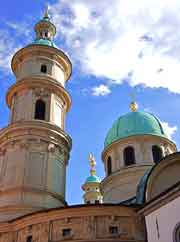Graz History Facts and Timeline
(Graz, Styria, Austria)

It is documented that there was a settlement in Graz during the Chalcolithic era of the Bronze Age, roughly 7,000 years ago, although little is known about its history during this period.
Similarly, whilst it is likely that settlements were based here during the Middle Ages, there is little in the way of historical evidence. It is not until the 12th century that most history books begin, when Graz was a small commercial town under the rule of the powerful House of Babenberg.
The Influential Habsburgs
Later on in the 12th century, the town came under the rule of the House of Habsburg, a notable European royal family famously descended from the Holy Roman Emperors.
During the 1300s, Graz was called home by the Austrian Habsburgs, who lived within the Schlossberg Castle and ruled over an extensive kingdom consisting of both Carinthia and Styria (southern Austria / northern Slovenia), as well as areas of
Italy.
An Age of Italian Renaissance and Educational Excellence
In the 1500s, Graz enjoyed a period of planning and restructuring, to improve its overall layout and set the foundation for a more impressive city. Leading architects arrived from Italy, along with Renaissance artists, and between them they created a number of magnificent buildings, such as the Landhaus and the Landhaushof courtyard, where local events are still staged today.
The University of Graz was founded at this time in history, being officially established in 1585 by Charles II, Archduke of Austria. This is now the country's second-most historic university, as well as being the second biggest in Austria. Currently called home by in excess of 20,000 students, the university comprises six different faculties and over the years, has produced a number of Nobel prize-winning laureates.
Fortifications and Battles
Over the years, Graz successfully fought off a number of attacks, and in 1809, the French Army was defeated. History records how the fortified Schlossberg was able to defend the city against French military leader Napoleon Bonaparte and his army of 3,000 - roughly three times more than the forces of Graz. In total, eight attacks were made against the Schlossberg, each of which was unsuccessful. These attacks ceased when
Vienna surrendered to the French, with Austria being defeated during the Battle of Wagram, another victory for
France.
Adolf Hitler Welcomed with Open Arms
In the year of 1938, Hitler arrived in the city and was given a warm reception by its residents. Soon after, Graz became a part of Nazi Germany and the local Jews were subsequently killed, with their beautiful synagogue destroyed. The period of prosperity and employment promised by Hitler was never to materialise and the Second World War saw considerable bombing by the Allies, destroying in the region of 15 percent of all the buildings in the city. Fortunately though, the historic Old Town miraculously remained relatively unscathed by these attacks.
Tourism in the Old Town
Sightseeing tourists enjoying time in Graz generally gravitate towards the Old Town, where a taste of Austrian history awaits. This part of the city joined the list of World Heritage Sites just before the new millennium and is known for its wide-spectrum of architectural influences.
Visitors should look out for the Landhaus (palace), the Rathaus (Town Hall), the Schauspielhaus (theatre) and the Opernhaus (Opera House). The dom (cathedral) is also located in Old Town Graz, with the Mausoleum of Emperor Ferdinand II standing next-door. Close by, the Schlossberg hill presides over the area, with its fortress ruins, famous clock tower (Hurter) and popular funicular railway (Schlossbergbahn).
 It is documented that there was a settlement in Graz during the Chalcolithic era of the Bronze Age, roughly 7,000 years ago, although little is known about its history during this period.
It is documented that there was a settlement in Graz during the Chalcolithic era of the Bronze Age, roughly 7,000 years ago, although little is known about its history during this period.